 With the UK solar panel Feed-in-Tariff arguably in quieter water now the Supreme Court appeal is rejected and the EPC ratings just came into place, it’s time to look forward. The general expectation is a further Feed-in-Tariff subsidy cut in July 2012 from 21 towards 16.5 pence, due to limited installations in March and July. However, the first three days of March could cause a more severe drop towards 13.6 pence – which could mean a cut of another 35%!
With the UK solar panel Feed-in-Tariff arguably in quieter water now the Supreme Court appeal is rejected and the EPC ratings just came into place, it’s time to look forward. The general expectation is a further Feed-in-Tariff subsidy cut in July 2012 from 21 towards 16.5 pence, due to limited installations in March and July. However, the first three days of March could cause a more severe drop towards 13.6 pence – which could mean a cut of another 35%!
According to the plans of DECC (see here, page 15) of the July subsidy cuts from the current level of 21 pence, the criteria are as follows:
- A: March and April 2012 volume > 200 MW – 13.6 pence (35% cut)
- B: March and April 2012 volume 150-200 MW – 15.7 pence (25% cut)
- A: March and April 2012 volume < 150 MW – 16.5 pence (21% cut)
Looking at the DECC numbers of weekly solar installations we see the following capacity additions in the weeks since the 3rd of March cuts:
- Week till Sunday March 11 – 5.4 MW
- Week till Sunday March 18 – 9.3 MW
- Week till Sunday March 25 – 15.1 MW
- Week till Sunday April 1st – 32.2 MW
This totals about 62 MW, and hence the strong expectation would be that the March / April volume would be less that 150 MW – since April is expected to be weaker than March following the new EPC requirements of at least a rating of D.
However, the goverment intentions talk about volumes in the entire month of March and April, which would include the 1st, 2nd and 3rd of March that were the last days before the deadline! And due to the boom-bust nature of the cuts the installations in this week were:
- Week till Sunday March 4 – 99.7 MW
